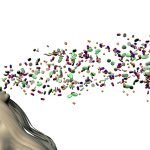Let me ask you a simple question: “Which is the greater threat to your life right now, MRSA (Methicillin-ResistantStaphylococcus aureus) or E. coli food poisoning?” Thanks to the conscientious work of the world’s media over the last few weeks, every single person that I posed this question to over the last few days, bar one, identified E. coli as the more significant threat.
Unfortunately, they were wrong? Very wrong!
How did you do?
In our last newsletter, we talked about the E. colioutbreak in Germany and how people were overreacting to it. Yes, 39 people are now dead, and that is certainly a tragedy for them and their families. But truth be told,E. coli doesn’t really kill that many people each year — maybe a couple of hundred in the United States last year, at the outside. When you consider that there are well over 300 billion meals eaten each year in the U.S., that’s an extremely low incidence. But that’s just E. coli. What’s the total number of deaths from all causes of food poisoning? According to the Centers for Disease Control, food borne diseases cause approximately 5,000 deaths in the United States each year. Three pathogens — Salmonella, Listeria, and Toxoplasma — are responsible for 1,500 of those deaths.1 E. coli, on the other hand, although it sickens thousands of people, only kills a handful of people each year. And yet, most people now believe it is a major killer and threat to life.
Not even close (thank you mainstream media).
MRSA wins in a landslide, and yet most people are not aware of how many deaths it is responsible for each year. In fact, MRSA accounts for some 19,000 deaths annually in the United States,2 and an equivalent number in Europe, more than all the deaths from HIV/AIDS and almost 400% more than all the deaths from food poisoning — from all bacterial sources. Treating MRSA in U.S. hospitals costs upwards of $3 billion annually, and it is only one of several widespread deadly pathogens that are becoming drug resistant.
But MRSA is yesterday’s news, and what news service wants to feature yesterday’s news?
What is MRSA?
I first wrote about MRSA back in 2006 in the middle of the bird flu furor. Remember bird flu? At the time, I said that despite media hysteria a bird flu pandemic was unlikely — worth watching out for, but unlikely. Instead, I focused the newsletter on what I considered a couple of far more serious threats, one of which was MRSA. At the time, nobody in the media was talking about MRSA. It just wasn’t as sexy as bird flu. A couple of years later, it started to get noticed after it suddenly appeared in the ocean and on public beaches. But then, just as quickly, it dropped off the map, and now appears only in occasional non-front-page stories. With that said, before we go any further, it’s probably a good idea to once again explain exactly what MRSA is.
Staphylococcus aureus (S. aureus, aka Staph) is a type of bacteria commonly carried on the skin and in the noses of healthy people without causing infection. This is known as bacterial colonization. However, when S. aureus invades the body, usually through a puncture wound on the skin, they can cause serious infections — in those with compromised immune systems. Most staph infections can be treated relatively easily with antibiotics. These types of infections are known as MSSA (methicillin-sensitive S. aureus). But some staph infections are now resistant to antibiotics, particularly methicillin, at one time the doctor’s first choice when dealing with staph infections. These types of infections, not surprisingly, are known as MRSA, or methicillin-resistant S. aureus. The obvious question, of course, is how did we get from MSSA to MRSA?
 Until the mid-20th century, Staphylococcus aureus was known as a relatively innocuous microbe. Any occasional infection was fairly easily treated through a variety of natural means. Then in 1941, penicillin, the first antibiotic was introduced, primarily to treat soldiers wounded during WWII. It was a miracle! Forget traditional methods of treatment. Even though they worked, they took time and effort. Penicillin was a silver bullet. Like magic, it quickly and easily killed staph infections. Who knew there would be a price to pay? In a mere two years, by 1943, the first reports of the bacteria’s resistance to penicillin started appearing — thus signaling its first step to becoming a “super” bug. Over the years, this new, more virulent version of S. aureus became more prevalent, steadily rendering penicillin more and more useless. It wasn’t until the early 1960s that methicillin, a “new” antibiotic, was determined to be effective against these new strains of staph infection, and quickly became the antibiotic of choice. Unfortunately, the first signs of resistance to methicillin appeared in less than a year. The resistant strain (MRSA) quickly became entrenched in hospitals in Europe, Australia, and America. By the early 1990s, MRSA infections had become the leading cause of hospital-acquired skin infections in the United States.
Until the mid-20th century, Staphylococcus aureus was known as a relatively innocuous microbe. Any occasional infection was fairly easily treated through a variety of natural means. Then in 1941, penicillin, the first antibiotic was introduced, primarily to treat soldiers wounded during WWII. It was a miracle! Forget traditional methods of treatment. Even though they worked, they took time and effort. Penicillin was a silver bullet. Like magic, it quickly and easily killed staph infections. Who knew there would be a price to pay? In a mere two years, by 1943, the first reports of the bacteria’s resistance to penicillin started appearing — thus signaling its first step to becoming a “super” bug. Over the years, this new, more virulent version of S. aureus became more prevalent, steadily rendering penicillin more and more useless. It wasn’t until the early 1960s that methicillin, a “new” antibiotic, was determined to be effective against these new strains of staph infection, and quickly became the antibiotic of choice. Unfortunately, the first signs of resistance to methicillin appeared in less than a year. The resistant strain (MRSA) quickly became entrenched in hospitals in Europe, Australia, and America. By the early 1990s, MRSA infections had become the leading cause of hospital-acquired skin infections in the United States.
To quote from my 2006 newsletter on MRSA, “In the last few years, MRSA has popped up in health clubs, high school gyms, sex clubs, jails, and schools — just about anywhere bacteria can grow. It has affected everyone from athletes to school children to newborn babies. It has become a growing problem that is largely unknown by the general population. Researchers at Olive View-UCLA Medical Center in Sylmar [California] analyzed skin infections that showed up in their emergency room. The results were nothing short of alarming:”
- In 2002, methicillin-resistant staph caused 29% of those infections.
- In 2004, just two years later, the rate was 64%
- In 2008, a new strain of MRSA appeared that demonstrated resistance to the antibiotic Zyvox, which was considered to be the one solution that would work when all other antibiotics failed
- And today it is killing an average of 19,000 people a year in the US alone.
- By 2010, the number of children hospitalized with dangerous drug-resistant staph infections had surged 10-fold over the previous decade.3
To be sure, not all the news on MRSA is bad. Doctors are getting better at dealing with it (at least the existing strains); and more importantly, at least from the doctors’ perspective, they are getting better at slowing its spread inside hospitals, which until now have been the primary points of infection for most people. In England and Wales, for example, deaths in hospitals involving Staphylococcus aureus (including those which did not specify methicillin resistance) fell by 16 percent, from 1,500 in 2008 to 1,253 in 2009.4 And in the U.S., despite the large number of deaths, the number of new MRSA infections is trending downward in both hospitals and in healthcare facilities. 5
What’s the problem?
Setting aside, for a moment, the high number of deaths, if MRSA’s trending downward — coming under control, as it were — what’s the big deal? Why devote an entire newsletter to a passé issue? Why not ignore it, pretty much like the news media has done?
Quite simply, because it’s not going away, and it’s not really under control! Think of it more as regrouping, probing our weaknesses, and waiting for the most opportune time to attack yet again. As Jeff Goldblum said in Jurassic Park, “Life finds a way.”
First, the mutating process for S. aureus hasn’t stopped. It’s fueled by the continued use of antibiotics. As I’ve discussed many times before, in any colony/strain of bacteria, there are a multitude of minor genetic variants among the individual bacterium. Some of these variants will have a built in advantage when it comes to surviving a particular antibiotic. Thus, when the colony is confronted by an antibiotic, those with no resistance to the antibiotic die off, leaving those with a natural resistance to survive and replicate. That means that any colony of bacteria is self-selective to breed resistant strains to any given antibiotic it encounters.
But that’s only the tip of the iceberg.
As we discussed in the last newsletter, since bacteria cells are everywhere, it is possible for them to acquire genetic information from other sources such as viruses, plasmids (self replicating bits of DNA), or just naked pieces of DNA floating about. In fact, it is not uncommon for bacteria to continually mutate and evolve, continually swapping genes with each other. And frighteningly, this often happens between entirely different species of bacteria. In effect, not only are bacteria programmed to “evolve” defenses against antibiotics (thus the danger in over-prescribing antibiotics), but once they produce such a defense, they are also programmed to rapidly share that defense with other species of bacteria — thus rapidly spreading that resistance from strain to strain and species to species.
For example, there’s the story of vancomycin, at one time the antibiotic of last resort. When all other antibiotics failed, doctors knew they could count on vancomycin. But then vancomycin resistance was discovered in a common hospital microbe, enterococcus. By 1991, 38 hospitals in the United States reported the variant. Frighteningly, just one year later, vancomycin resistant Staph bacteria were observed with the same gene. To repeat, what this means is that not only are bacteria programmed to “evolve” defenses against antibiotics, but once they produce such a defense, they are also programmed to rapidly share that defense with other bacteria — thus rapidly spreading the resistance.
Once you understand this, it’s easy to see why hospitals provide the perfect breeding ground for resistant MRSA. Since they are filled with so many vulnerable patients, infections are common and easily spread. Now into this witches’ cauldron of deadly microbes, throw all of these different strains of bacteria together with the many, many doses of every kind of antibiotic used in these hospitals each and every day, and it’s easy to see how you exponentially accelerate the natural selection process.

But let’s set that aside for the moment. Let’s pretend that doctors are temporarily winning the battle against S. aureus with antibiotics. Are we not once again confronted with Jeff Goldblum’s aphorism from Jurassic Park, “Life finds a way?”
The answer is absolutely! And we see evidence of this in two ways.
First, although the problem of MRSA initially appeared in hospitals, it has now become a problem in the community at large. At first this might not seem surprising — it escaped the confines of the hospital — until you learn that MRSA in the community is very different from the MRSA found in hospitals. It seems to have developed quite separately, and has several unique qualities — most notably that it causes infections in previously healthy individuals who don’t have the risk factors found in hospitalized patients. In fact, community based strains produce a unique toxin called PVL (panton-valentine leukocidin), which increases the ability of the bacteria to cause infections. “Life finds a way.”
And then, since simple mutation might no longer be enough, S. aureus is finding new ways to spread itself faster, with the idea being that if it can spread far enough and fast enough, it can ultimately overwhelm our ability to kill it with antibiotics — thus ensuring its survival regardless of what antibiotics it must face. This is not a conscious decision, but the simple mathematical certainty of natural selection. And thus we see:
MRSA in meat
Just two weeks ago, Emerging Infectious Diseases published a study that found that some beef, chicken, and turkey sold in Michigan grocery stores contained methicillin-resistant Staphylococcus aureus. The study found that 20.5 percent of the beef tested showed positive for S. aureus, 25 percent in chicken, and 24.6 percent in turkey. Six samples — two in beef, three in chicken and one in turkey — showed positive for MRSA.6
And although, as the researchers stated, cooking kills MRSA, handling the infected meat before cooking transfers the bacteria to your hands — thus infecting you if you have any open wounds on your hands. Of course, then your hands become a source for infecting any other food you touch — as does your cutting board, counter tops, plates, and sink. MRSA is now everywhere in your kitchen, even after you cook the meat.
But even worse was a study sponsored by the FDA and published in the journal of Clinical Infectious Diseases, which tested beef, chicken, pork, and turkey purchased from grocery stores in Chicago, Los Angeles, Washington, D.C., Flagstaff, Ariz. and Fort Lauderdale, Fla. This study, which is believed to be representative of the condition of meat across the United States, found that over halfof all the samples tested contained S. aureus. But even more disturbing was the fact that half of those samples tested positive for strains of MRSA that were resistant to at least three different kinds of antibiotics.7 Statistically, that means that every fourth package of meat, poultry, or pork that you bring into your house is leaving MRSA colonies all over your kitchen.
MRSA superbug in milk
And it’s not just meat; MRSA is now also turning up in dairy products. British scientists found a new strain of MRSA in milk from cows and in swab samples from humans.8 And even worse, the researchers say that this new strain cannot be detected with standard tests. Before you panic, the researchers did say that although the discovery was “worrying,” they found it unlikely that this new strain of MRSA could cause infections by getting into the food chain via milk — as they believed pasteurization of milk would prevent any risk of infection via the food chain.” Comforting, but untrue! The researchers seem not to have considered the possibility of post-pasteurization contamination9 — let’s say from a worker who handles the milk pre-pasteurization and then accidentally touches some equipment down the line — or touches the carton while loading it onto the truck. Nevertheless, the researchers acknowledged that their findings did raise questions about whether cows could be a reservoir for the new strains of MRSA.
Bed Bugs
 And then, just when you thought it was safe to go to sleep at night! Researchers recently found bedbugs that were carrying staph “superbugs” on three patients at a hospital in a poor area of Vancouver.10 Five bedbugs were collected and found to be carrying two types of drug-resistant bacteria. Even worse, three of the bedbugs were found to be carrying MRSA. That’s not to say that the bugs were actually spreading MRSA; there’s no evidence they were…and there’s no evidence they weren’t. And to tell the truth, that’s not the point. It’s just one more piece of evidence that “Life finds a way” to spread itself. That said, bedbugs would be an ideal way for MRSA to spread. Once almost absent in the developed world, bedbugs are back with a vengeance swarming into major cities, including some of the most upscale neighborhoods in the world. That omnipresence would allow MRSA into contact with humans in ways never before possible. And because the nature of bedbugs is to bite you and cause bleeding, they provide that crucial entry point for MRSA into your skin and bloodstream, the open wound. Nothing is definite, but the potential for infection on a wide scale if bedbugs truly start carrying viable MRSA strains is highly disturbing. And it probably should be mentioned that the reason for the study in the first place was that the researchers noticed a “simultaneous boom” in both bedbugs and MSRA infections in the Vancouver neighborhoods in which they ultimately found the “MRSA-fied” bedbugs.
And then, just when you thought it was safe to go to sleep at night! Researchers recently found bedbugs that were carrying staph “superbugs” on three patients at a hospital in a poor area of Vancouver.10 Five bedbugs were collected and found to be carrying two types of drug-resistant bacteria. Even worse, three of the bedbugs were found to be carrying MRSA. That’s not to say that the bugs were actually spreading MRSA; there’s no evidence they were…and there’s no evidence they weren’t. And to tell the truth, that’s not the point. It’s just one more piece of evidence that “Life finds a way” to spread itself. That said, bedbugs would be an ideal way for MRSA to spread. Once almost absent in the developed world, bedbugs are back with a vengeance swarming into major cities, including some of the most upscale neighborhoods in the world. That omnipresence would allow MRSA into contact with humans in ways never before possible. And because the nature of bedbugs is to bite you and cause bleeding, they provide that crucial entry point for MRSA into your skin and bloodstream, the open wound. Nothing is definite, but the potential for infection on a wide scale if bedbugs truly start carrying viable MRSA strains is highly disturbing. And it probably should be mentioned that the reason for the study in the first place was that the researchers noticed a “simultaneous boom” in both bedbugs and MSRA infections in the Vancouver neighborhoods in which they ultimately found the “MRSA-fied” bedbugs.
You need to understand that the insecticide DDT had pretty much wiped out bedbugs some fifty years ago, but once DDT was no longer legal, and with the increase in international travel, it opened the door for the nasty little biters to thrive and multiply. And starting around 2004, the supposedly eradicated bedbug made a surprise resurgence in the US, Canada, Australia, and Western Europe alarming hotel owners, hospital personnel, and victims. In parts of London, bedbug infestations have risen tenfold since 1996. In the U.S., the National Pest Management Association reports a 500 percent increase in bedbug numbers in the last few years.11
In fact, for the past several years, the pest extermination company, Terminix, has published an annual list of the most bedbug-infested cities.12 And according to the May 2011 list, New York is once again the most bedbug-infested city in the United States. (The other cities rounding out the top five are Cincinnati, Detroit, Chicago, and Philadelphia.) In New York alone, bedbugs have already invaded landmarks such as:
 The United Nations
The United Nations- Lincoln Center
- Waldorf-Astoria
- The Empire State Building
- Bloomingdale’s
- Niketown, the flagship Nike store
- New York Public Library
- Time Warner Center
- The clothing giants Abercrombie, Hollister, and Victoria’s Secret
- Fox News
- And last but not least, the Department of Health
Amazingly, this infestation has spawned an entire new industry: the raising and training of bedbug sniffing dogs. Bedbugs do not emit an odor that the human nose can detect, but the smell is something dogs can be taught to sniff out, in much the same way they can be trained to detect explosives and narcotics. Incidentally, trained dogs cost between $10,000 and $12,000 apiece.13
And if you can’t afford to bring a dog with you, you can always check out The Bedbug Registry14before you travel to find out if your hotel has a known infestation. And, if you live in area where one is available, you can pay for a trained dog to “sniff out” your house.
And let’s not forget that what we’re talking about here is not just a massive resurgence of bedbugs, but the potential that this mass infestation might become a mass infection system for ever new strains of MRSA that are ever more resistant to ever more antibiotics.
Conclusion
The medical approach to dealing with MRSA is a pretty basic two-step approach:
- When one antibiotic stops working, switch to another. When penicillin stopped working, they switched to methicillin. When methicillin stopped working they switched to vancomycin (the most powerful antibiotic so far discovered). And when vancomycin stopped working, they moved to step 2.
- So far, MRSA strains are not necessarily “immune” to the different antibiotics — merely, highly resistant. That means that antibiotics are not completely powerless against bacteria — just not very effective. This forces doctors to use ever higher doses of antibiotics and over a much longer period of time. The problem is that this is a game that S. aureus must eventually win. Eventually, you reach an upper limit on dosage before you start seeing life-threatening side effects…effects so obviously devastating that even doctors can no longer ignore them.
So what do we do when MRSA finally evolves into MISA (Methicillin Immune Staphylococcus aureus), and no feasible amount of antibiotics can help?
Fortunately, there are two proven things that can be done. One of which is in your hands; and one is in the hands of the medical community — if they choose to implement it.
What you can do
Keep your immune system optimized so that it can resist any staph infection. In normal circumstances, that’s what it does anyway, pretty darn effectively. That’s why, even though staph germs are everywhere, you rarely come down with any staph infections — although as we discussed earlier, community staph infections are violating this principle. In any case, we’ve discussed many times before how to do this. In summary, here is a list of immune boosters:
 Echinacea
Echinacea- Pau d’arco
- Suma
- Astragalus root
- Medicinal mushrooms
- Beta 1-2/1-6 glucan
- Aloe vera
- Alkylglycerols
- Lactoferrin
- Bovine colostrums
- Glutathione
- Mangosteen
For more information, check out the last section in the E. coli Outbreak newsletter.
And if you ever come down with an infection, you will want to make use an array of natural pathogen destroyers. Use them heavy; use them strong; use them in combination; and use them long enough to make sure the infection is good and gone. Here’s a list of natural pathogen destroyers:
- Garlic
- Onion
- Ginger
- Olive leaf extract
- Habanero and horseradish
- Liquid Ionic Zinc
- Oil of Wild Mountain Oregano
- Apple-Cider Vinegar
For more information, check out Why Antibiotics and Antivirals Fail.
And for staph infections on your skin, look for silver based topical formulas such as American Biotech Labs’ ASAP Ultimate Skin & Body Care gel, which contains 24 ppm of Silver Sol. The silver particles in Silver Sol are permanently suspended in water, where the mineral’s charge is transferred to the entire body of water. It’s effective.
What the medical community can and should do
Up until the mid-70’s, Norway had the same problem with MRSA as every other country, but twenty-five years ago, Norway’s public health system decided to do a 180 and completely reverse the typical medical approach to dealing with aggressive pathogens. They said no to the unconstrained use of antibiotics. The result is that Norway is now recognized as the most infection-free country in the world!15 So exactly what did they do?
- First and foremost, recognizing that antibiotics were the cause of the problem at least as much as they were helping deal with it, Norwegian health authorities drastically cut back on the use of antibiotics. Norwegian doctors now prescribe fewer antibiotics than any other country in the world. Quite simply, this prevents people from developing resistance to the antibiotics, while at the same time prevents the bacteria from developing resistant strains. How well does it work? Penicillin is still effective, and prescribed, for many infections in Norway!
- Patients with MRSA are isolated, and medical staff who test positive stay at home — thus removal hospitals as breeding grounds.
- And doctors track each case of MRSA by its individual strain, interviewing patients about where they’ve been and who they’ve been with, testing anyone who has been in contact with them. They nip any possible spread of the strain before it has any chance to gain momentum.
It’s that simple! But unless you live in Norway, don’t count on it happening anytime soon in your country’s medical system. In the rest of the world, doctors are addicted to their drugs, which means, you need to focus on the things you can do to take care of yourself!

- 1.Paul S. Mead, Laurence Slutsker, Vance Dietz, Linda F. McCaig, et al. “Food-Related Illness and Death in the United States.” Emerging Infectious Diseases. CDC. 19 June 2011. <http://www.cdc.gov/ncidod/eid/vol5no5/mead.htm>
- 2.R. Monina Klevens, DDS, MPH; Melissa A. Morrison, MPH; Joelle Nadle, MPH; Susan Petit, MPH; Ken Gershman, MD, MPH, et al. “Invasive Methicillin-Resistant Staphylococcus aureus Infections in the United States.” JAMA. 2007;298(15):1763-1771. <http://jama.ama-assn.org/content/298/15/1763.full>
- 3.Associated Press, “Hospitals see dramatic rise of kids with MRSA.” 19 May 2010. USA Today. Accessed 20 June 2011. <http://www.usatoday.com/news/health/2010-05-19-mrsa-staph-infections_N.htm>
- 4.Unknown, “MRSA.” Office of National Statistics, Accessed 20 June 2011. <http://www.statistics.gov.uk/cci/nugget.asp?id=1067>
- 5.Laura Blue. “Staph ‘superbug’ infections are on the decline.” 10 August 2010. Time Healthland. Accessed 20 June 2011. <http://healthland.time.com/2010/08/10/superbug-infections-are-on-the-decline/>
- 6.Kanika Bhargava, Xiaogang Wang, Susan Donabedian, Marcus Zervos, Liziane da Rocha, and Yifan Zhang. “Methicillin-Resistant Staphylococcus aureus in Retail Meat, Detroit, Michigan, USA.” EID Journal Volume 17, Number 6-June 2011. <http://www.cdc.gov/eid/content/17/6/1135.htm>
- 7.Andrew E. Waters, Tania Contente-Cuomo, Jordan Buchhagen, Cindy M. Liu, et al. “Multidrug-Resistant Staphylococcus aureus in US Meat and Poultry.” Clin Infect Dis. (2011) 52(10): 1227-1230 first published online April 15, 2011. <http://cid.oxfordjournals.org/content/52/10/1227.full.pdf+html?sid=d1a1cec1-3abf-4f4a-aa16-fe40c1d2c826>
- 8.Laura Garcia-Alvarez, Matthew TG Holden, Heather Lindsay, Cerian R Webb, Derek FJ Brown, Martin D Curran, Enid Walpole, Karen Brooks, Derek J Pickard, et al. “Meticillin-resistant Staphylococcus aureus with a novel mecA homologue in human and bovine populations in the UK and Denmark: a descriptive study.” The Lancet Infectious Diseases, In Press, Corrected Proof, 3 June 2011. <http://www.sciencedirect.com/science/article/pii/S1473309911701268>
- 9.Department of Food Science, “BASIC DAIRY BACTERIOLOGY.” Version 06-01-10. Cornell University. accessed 7 June 2001. <http://foodscience.cornell.edu/cals/foodsci/extension/upload/CU-DFScience-Notes-Bacteria-General-Dairy-Micro-06-10.pdf>
- 10.Lowe CF, Romney MG. Bedbugs as vectors for drug-resistant bacteria. EID Journal. Volume 17, Number 6–June 2011. Accessed 21 June 2011. <http://www.cdc.gov/EID/content/17/6/1132.htm>
- 11.James Owen. “Bloodthirsty Bedbugs Stage Comeback in U.S., Europe.” 13 May 2004. National Geographic News. Accessed 21 June 2011. <http://news.nationalgeographic.com/news/2004/05/0513_040513_bedbugs.html>
- 12.Press Release, “ANNUAL LIST IDENTIFIES WHERE BEDBUGS BITE MOST ACROSS U.S.” May 2011. Terminix. Accessed 21 June 2011. <http://www.terminix.com/Media/PressReleases.aspx>
- 13.Lena H. Sun. “Demand for bedbug-sniffing dogs skyrocketing” 28 May 2011. The Washington Post National. Accessed 21 June 2011. <http://www.washingtonpost.com/national/health/demand-for-bedbug-sniffing-dogs-skyrocketing/2011/05/27/AGFKIYDH_story.html>
- 14.Maciej Cegłowski. The Bedbug Registry. Accessed 22 June 2011. < http://bedbugregistry.com/>
- 15.Martha Mendoza, Margie Mason. “Antibiotic Overuse? Not in Norway.” 31 Dec 2009. Spotlight on Prevention. Accessed 22 June 2011. < http://hospitalacquiredinfections.blogspot.com/2009/12/antibiotic-overuse-not-in-norway.html>












Doc, great info , but what is
Doc, great info , but what is up with the last picture? These folks look like they just gave me my lab results, and I told them I don’t know her last name. Enjoy
Dear Jon, I read your Article
Dear Jon, I read your Article that MRSA is Building Momentum. Thank you for this extremely important information. As I looked for the section on the solution to overcoming MRSA, I was somewhat disappointed that the product called Silver Sol was not included. This is a patented Silver process that will kill MRSA on Contact. Now I know this comment may come on to deaf ears. However, I challenge you to research the findings of Dr. Gordon Pedersen concerning Silver Sol. Watch the video by Dr. Pedersen where he talks about the effect of Silver Sol MRSA. I will look for your comments. Armand E. Dion
I HAVE READ MANY PLACES THAT
I HAVE READ MANY PLACES THAT COCONUT OIL (LAURIC ACID) CAUSES THE MEMBRANE OF THE MRSA BACTERIA TO DISSOLVE AND MAYBE DETOXES E COLI TOXINS.
CoConut oil is good
CoConut oil is good internally and externally. Look for the book Coconut Cures. I use this on wounds and within one day it is sealed making exposure to bacteria null and void. I lather the wound down or keep a cloth with it on it on top of the wound—-a little slippery but very effective. It slows down bleeding and prevents a lot. Taking it is just as good. I have lathered many wounds and nothing negative has happened just a lot of healing.
It is a shame that this
It is a shame that this country just cannot accept the scientific research done by other countries. When I lived in England, 15 years ago, they were using essential oils in hospitals there to SUCESSFULLY get rid of MRSA. The results were published in various scientific journals but ignored and scoffed at by the medical profession here. They also has success with using Tea Tree in the hospital’s ventilation system in combatting Legionnaire’s Disease.
Jon,
You mention a particular
Jon,
You mention a particular silver product for antibiotic properties. What do you think of Mesosilver, which claims sub-nanometer sized particles (e.g. maximum surface area) but whose claim has been disputed elsewhere?
Thanks,
Jonathan
I am th agent for a product
I am th agent for a product called Aqua Salveo, a water disinfectant, which has been approved by Italian Ministry of Health after 4 years of trials, for use in disnfecting water to make it safe for human consumption. It contains no chlorine. It contains food grade silver ions, copper ions and zinc ion,in the correct balance,the ions give off positive charges, the water negative so you get this constant electrical charge going on, +/-,+/- in the water, which kills all forms of bacteria, in comparative trials it has kept water bacteria free in a container for 24 months at a temperature of 35°C/95°F, while other untreated sample contained thousands of bacteria after 5 days, all achieved with with one treatment of 3 drops( 0.90ml) per liter. (The product is a concentrated blue colored liquid that is diluted into water,the smallest size availableis a 10 ml bottle that will treat 100 liters, it's odourless and tasteless). It kills Vibrio cholerae;Staphylococcus aureus, Salmoonella typhimurium, Candica albicans, Pseudomonas aeruginosa, Somatic coliphages; It is being used in South Africa where it is produced in an ISO 9001:2008 approved facility, as a process aid in food industry in killing e-coli by washing vegtables in a tank of trated Aqua salveo treated water,giving days of longer shelf live in supermarkets to the lettuce, cucumbers, salads, perpers, etc, the oxidation process is slowed right down. In a home experiment with coriander, washed in 500 ml of water with 2 drops of Aqua Salveo, in contact with coriandr for 10 minutes, skake off excess water, placed in airtight container, then placed in fridge, 4 days later was perfect for use, then left in fridge to see how long it would last , checking it every 3-4 days, it lasted 13 days before showing signs of limp and discolor, used Coriander salad lasted 17 days It is being used in Ghana in drinking water of chickens, the deaths of new born chickens fell from 12.5% to less than 1% in crowded conditions. The product can be used to wash all vegatables and keep them fresh, it kills e-coli, and would have been effective against a normal outbrak of e-coli in Germany, and maybe possibly effective against the recent German outbreak, it would need trials to know for sure as a report from an eminent British source claims that the E-coli outbreak in Germany is such a powerfull mutational strain that it had to have been produced in a biological warfare lab, then somehow escaped from a laboratory) To get it used in every other EU country, the barriers are up, no one will allow it to be sold in Belgium, because it has not been passed by Belgian authoritiese, the same for Germany, every country has baricades up, it's as if Belgian humans have diferent physical qualities from Italina human beings etc MRSA No bacteria can survive in a Ph lower than 2.8 PH I make up a solution of water with 6 drops in 50 ml jar with spray top and use it to spray on my skin when I get mosquito bites, or cuts, it eats the bacteria off the wound and the wound heals quickly, I also use it to gargle, to kill Staph in my throat, I belive it can be used in the fight against MRSA but have no way to establish if so or not without somehow trials beein set up in some hospital. We also have a hand sanitizer producr called Human Glove still awaiting results of trials at Italian Ministry of Health, which I believe can be used in the fight against MRSA as it contains a tiny % of glutaraldehyde amongs other things. But again trials taking years and years for each country when people (all of us the same physically on the inside) are dying horribly painfull deaths, but the beurocrats in the Health agency's of each individual country in Europe deny and denigrate the good works of another Health Ministry also inside the European Union. Meanwhile the product is being used extesively to purify water in Arica with UNICEF one of biggest customers Kind regards, James Moloney Agent for Aqua Salveo Products Benelux, France, Germany, Ireland Korte Herentalsestraat 4/4 Antwerp Belgium Testimonials available
Yesterday I saw a report on
Yesterday I saw a report on RT television where they developed a new bandage that traps (not kills) these kinds of viruses. They were having very good results with the recovery time half of what it would be with antibiotics.
MRSA is not a virus.
MRSA is not a virus.
I just received a booklet
I just received a booklet abouta Norwegian doctor (Dr. Raa) that developed a Beta 1,3/1,6 Glucan that caught on and is being used in Norway also.
Hi Armand,
You may want to
Hi Armand,
You may want to read Jon's article closely. Jon mentioned in the article to "look for silver based topical formulas such as American Biotech Labs' ASAP Ultimate Skin & Body Care gel, which contains 24 ppm of Silver Sol." If you will note, this is the exact same product that Dr. Gordon Pedersen is selling on his website.
You fail to mention the role
You fail to mention the role of EGCG (epigallocatechogallin) or Green Tea Extract. Compounding pharmacists, like myself, add this to vancomycin-containing wound gels [along with other ingredients] to synergize with the cephalosporins and other antibiotics to render them more effective against MRSA. Green Tea catechins (specifically EGCg) inhibit *MMP activities and processes that initiate MMP activation.
*Matrix Metallo Proteinases
REF: Yamada H, Tateishi M, Harada K, et al. A randomized clinical study of tea catechin inhalation effects on methicillin-resistant Staphylococcus aureus in disabled elderly patients. J Am Med Dir Assoc 2006;7(2):79-83.
Great job on this article!
Great job on this article! These malignant microbes can be taken from the air in hospitals and that would help a lot to reduce the spreading of germs. Filtration is good but photocatalytic oxidation is better. It would be great if they did that anywhere (air purification) they had large groups of people. Overuse of antibiotics will destroy us eventually. Keep writing! zandair.com
Fantastic stuff Akwaton – a
Fantastic stuff Akwaton – a highly disinfectant product prevents / kills many toxins improves drinking water, eliminates MRSA and many pathogens, proctects seeds, vegetables, fruits. cleans hard surffices and keeps free of all germs for hours.
Hi Jon
Have you considered
Hi Jon
Have you considered using an ultraviolet lamp to kill bacteria etc on surfaces, like countertops, and also drinking water?
Jon, Why the picture of
Jon, Why the picture of phages ? Perhaps a hidden hint at another way to go ?
Hi.
Hi.
So I live in Norway.
Got Staph from SOMEWHERE and went to the doctor.
Was put on antibiotics as my arm was twice the size. It came back after it went away. Now, after three doctors and one specialist… I am on my own… Specialist said two years and it goes away by itself… Just not true…. Not impressed with all doctors… – Bentonite Clay = REALLY Good detox